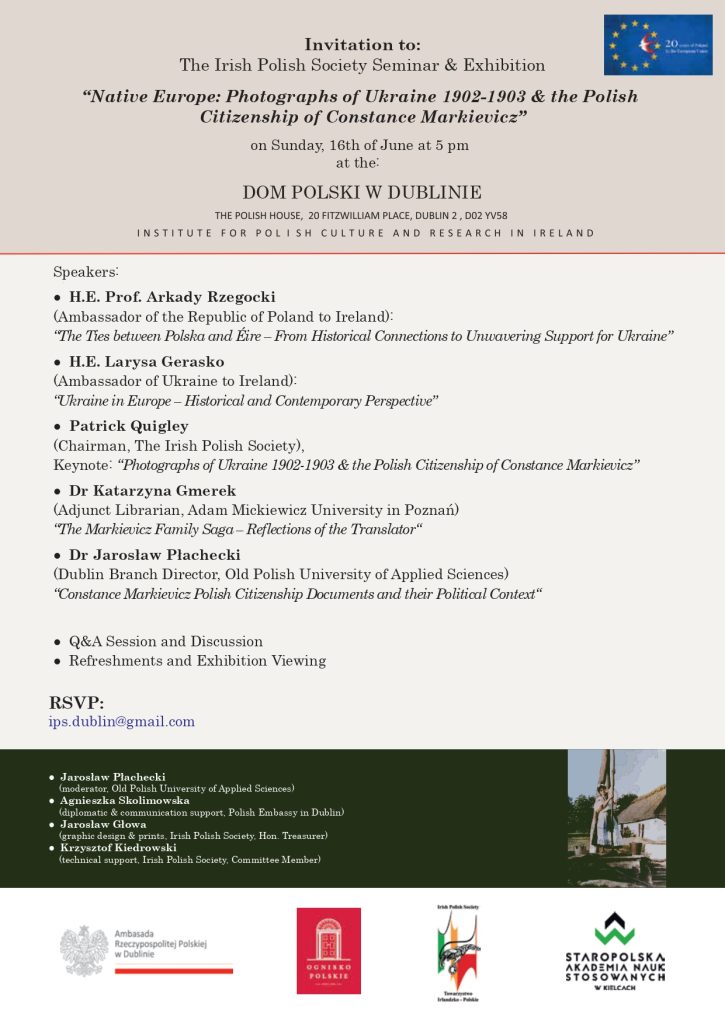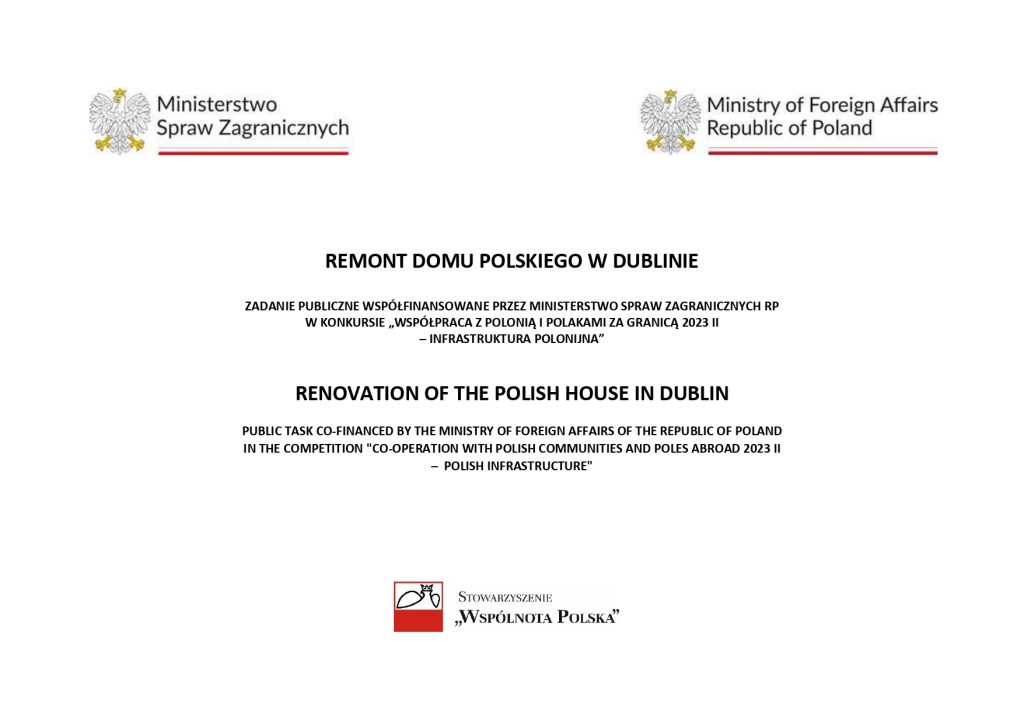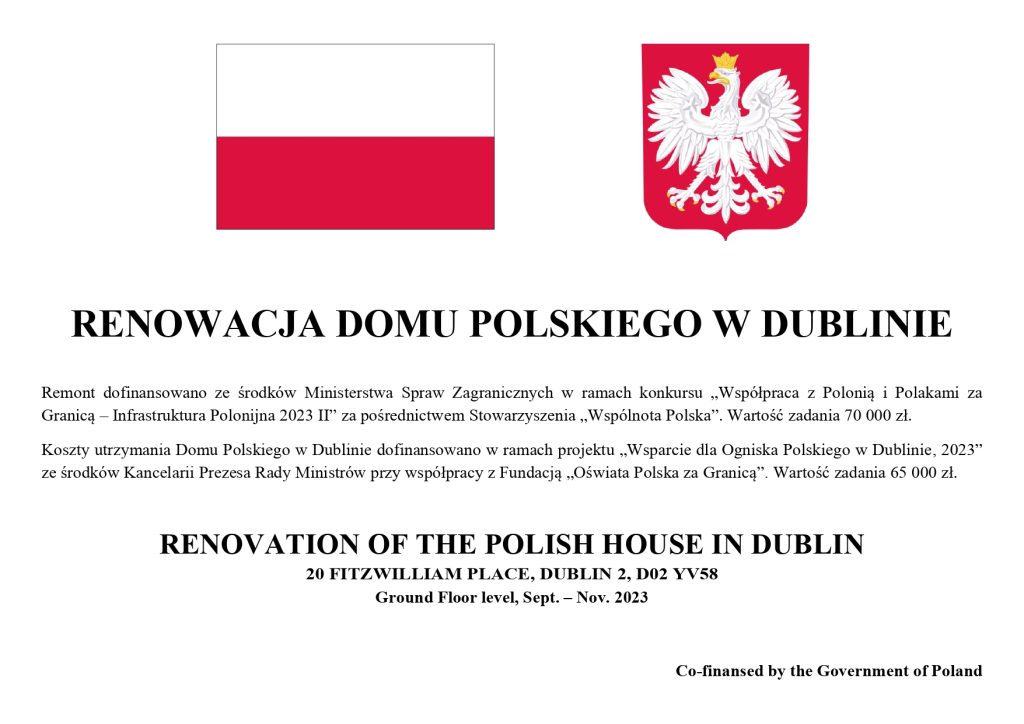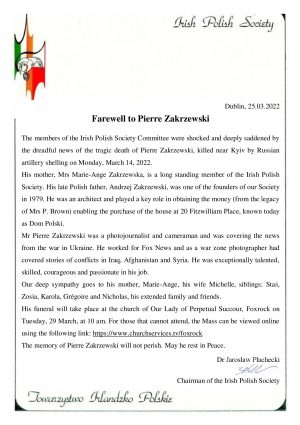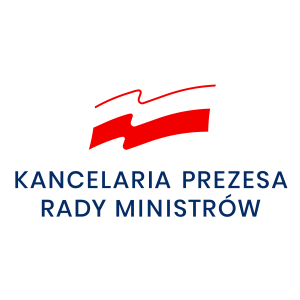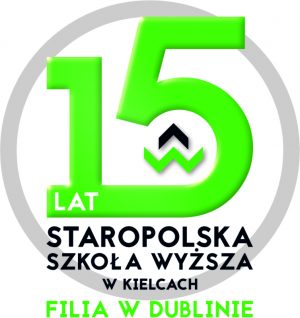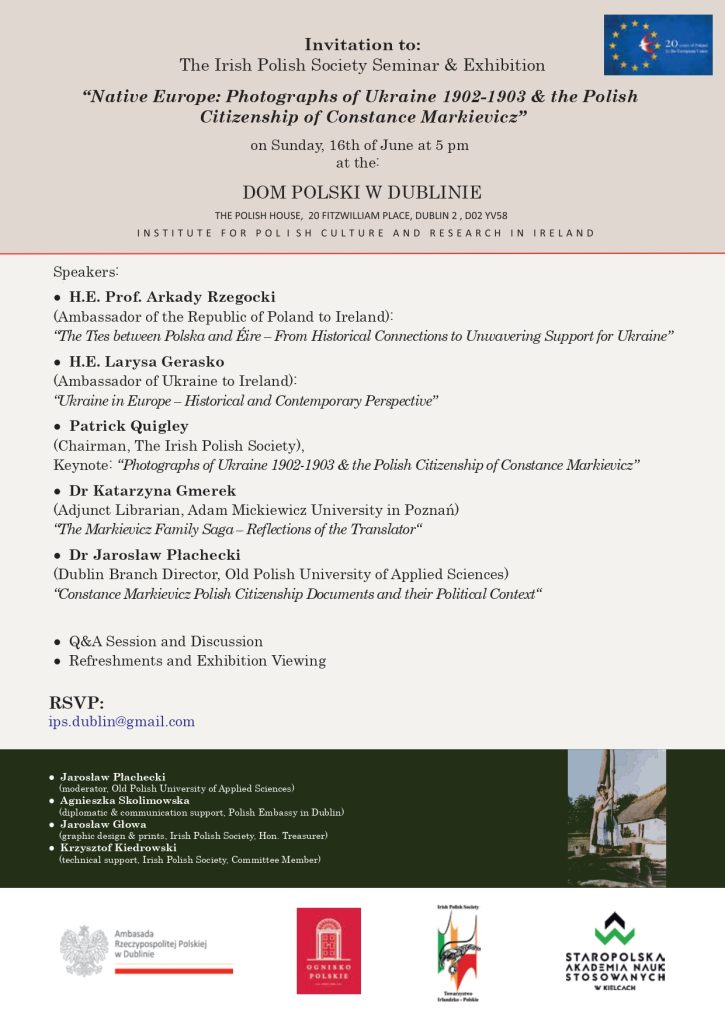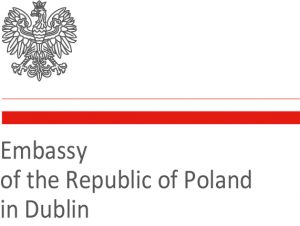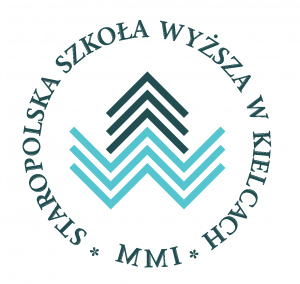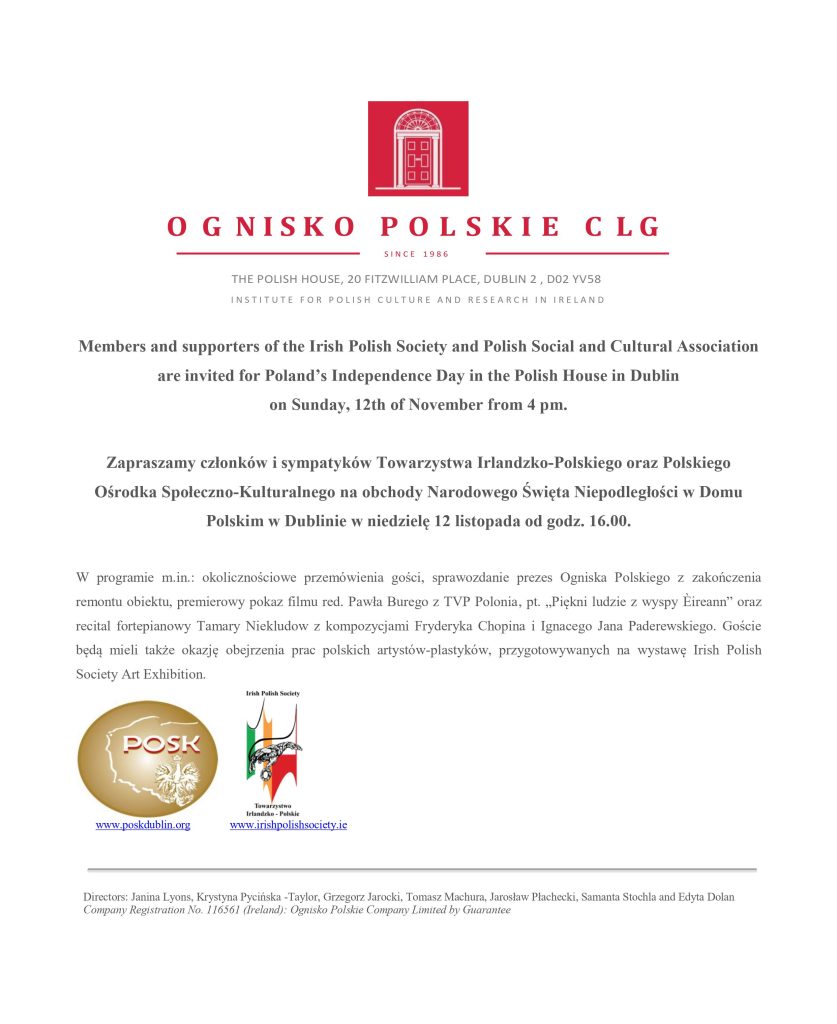Memorial service for the Polish elite on 1st Anniversary of Smolensk Plane Crash and 71st Anniversary of Katyn Massacre
April 7, 2011 by IPS · Leave a Comment
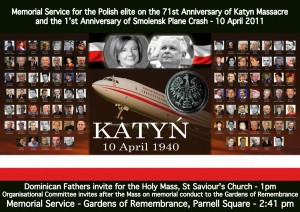 On behalf of Organisational Committee we would like to invite for “Memorial service for the Polish elite on 1st Anniversary of Smolensk Plane Crash and 71st Anniversary of Katyn Massacre” in the Gardens of Remembrance on 10th April 2011 at 2:41 pm.
On behalf of Organisational Committee we would like to invite for “Memorial service for the Polish elite on 1st Anniversary of Smolensk Plane Crash and 71st Anniversary of Katyn Massacre” in the Gardens of Remembrance on 10th April 2011 at 2:41 pm.
The event that is due to take place is similar that was held on 18th April 2010, where the Gardens were used as a place where the Polish community in Ireland could bid farewell to their President and other reprsentatives of Polish elite killed in tragic plane crash on 10th April 2010.
This year we are planning 1st Anniversary Memorial Service for the ones that perished last year as well in memory of Polish officers killed 71 years ago in Katyn, USSR.
The initial plan is:
Mass held in St Saviour’s dominican church at 1pm.
March between St Saviour’s church and Gardens of Remembrance, with people holding Polish and Irish flags, as well as the banner with the victims and the flowers.
The ceremony at the Garden to start at 2:41 pm as the official hour of the plane crash stands at 8:41 am Polish time.
The ceremony is to consist of the following:
Greeting of the gathered – the representatives of Dublin City Council, Polish authorities,the clergy and all the atendees.
Laying of wreaths, candles and flowers.
Polish National Anthem and declamation of Polish poet’s poem “Buttons” in Polish and English.
Buttons
Only the buttons did not yield
Witness of crime that survived death
They come from depths upon the surface
The only tribute on their graves
They are attesting God will count
Extend his mercy upon them
But how to raise from the dead
If they’re a clammy piece of earth
A bird flew over, a cloud is passing
A leaf is dropping, a mallow grows
Heavens above are filled with silence
The Katyn forest smokes with fog
Only the buttons did not yield
Powerful voice of silenced choirs
Only the buttons did not yield
Buttons from coats and uniforms
Appeal of the Perished – remembering the victims of these tragic events.
Expression of thanks and good-bye.
The event as a whole is to last approximately 1 hour 30 minutes and we expect approximately 1000 people to attend, as last year the number stood at around 3000. The event is naturally free of charge.
On that evening the Sunday 10th April 2011 at 8.00pm the Pro-Cathedral Concert Series 2010-2011 In association with RTE Lyric FM and Blanaid Murphy, Artistic Director, are inviting for Bach St. John Passion concert. Performs Polish soloist Jacek Wislocki as Evangelist & soloists from the Boys and Gentlemen of the Palestrina Choir and Orchestra of St. Cecilia.
Tickets 20 euro.
https://www.ctb.ie/tickets/ctb/
Day before on the 9th of April 2011 at 7:30 pm. in the Kevin Barry Room of the National Concert Hall the National Chamber Choir will perform Henryk Gorecki: Songs of Rodziny Katynskie ( Katyn Families songs).
http://www.nationalchamberchoir.com/
On the 13th of April, the entire Polish nation will observe the Day of Remembrance for the Victims of the Katyn Massacre (Dzień Pamięci Ofiar Zbrodni Katyńskiej) enacted by Polish Sejm to do homage to the Victims and to pay tribute to everyone who was murdered by the NKVD by power of a decision of 5th March 1940 taken by the highest authorities of the Soviet Union. 2010 marks the 70th anniversary of this crime. What is the Katyn massacre? Why were 21,000 Poles executed? Why does the Katyn massacre continue to divide Poles and Russians? This text answers these questions.
Katyn 1940 – a crime without punishment
What is the Katyn massacre?
The Katyn massacre was the mass murder of over 14,000 Polish prisoners of war and nearly 7,500 civilian prisoners (in total over 21,000 people), which took place in the spring of 1940 by order of the highest authorities of the Union of Soviet Socialist Republics (USSR). Therefore, the Soviet state is responsible for this massacre, so to speak — its functionaries, both of the state and the party. The name of the massacre comes from a place, called Katyn, near Smolensk, where the first graves of those who had been murdered were discovered.
Why is executing 21,000 Poles a massacre?
First, the victims were defenseless prisoners of war, whom international law forbade killing. Next, the civilian prisoners had not committed any crimes against the Soviet Union, so the decision to execute them was an atrocity.
What kind of crime is the Katyn mass murder?
It is both genocide (since the members of a specific national group were killed), a war crime (since the victims were prisoners of war) and a crime against humanity (since civilian prisoners were killed for political reasons — on the basis of unsubstantiated accusations).
How did Polish prisoners of war end up in Soviet captivity?
After a period of mutual hatred in the 1930’s, Bolshevik Russia and Nazi Germany, much to the surprise of public opinion worldwide and even of some communists, put their hostilities aside within a few months in 1939 and became political allies. Both the ideology and treaties signed with other countries, including the Polish-Soviet non-aggression pact of 1932, were directed on territorial expansion. The process of uniting these aggressive powers was sealed on the 23rd of August, 1939 in Moscow, when the USSR and the Third Reich signed a non-aggression pact, known to the world as the Ribbentrop–Molotov pact. It contained a secret protocol, in which both partners anticipated the liquidation and partition of the Polish state.
After Hitler invaded Poland, the Soviet Union joined the attack on the 17th of September, 1939; by doing so the Soviet state perpetrated the very same act of aggression against the Polish state as Hitler Germany did., . Russians cannot change that by explaining that the Polish state had “collapsed”, or that by crossing the Polish border, the Soviet Union was :protecting” its western frontier from the German threat. The Soviet Union did not have the right to declare the collapse of the Polish state, just as it did not have the right — under no circumstances — to cross Polish national borders.
Of course, in the wake of prevailing Soviet and German forces Poland had to surrender. The fates of the soldiers who fought varied. Thousands died, some of them managed to leave the country, and the rest were taken prisoner by the Germans or the Soviets. One more thing should be mentioned here. Both the Germans and the soldiers of the Red Army perpetrated terrible crimes against Polish Army soldiers. Even Soviet sources do not deny that. Here are some accounts from reports by the Red Army about these events: “On the 27th of September, after fighting with the Polish Army, fifteen soldiers were taken prisoners. By order of the lieutenant major from the 146th rifle regiment, Bulghakov, acting in agreement with the senior political instructor Kandiurin, the prisoners were lined up and shot with cannons”,;“On the 21st of September, the leader of the Special Division of the 2nd Calvary Corps, Kobierniuk, shot ten police officers without trial in the presence of the military prosecutor of the 2nd Calvary Corps, Ilitchev, and the representative of the War Tribunal, Mielnitchenko”.
Let us come back to the fate of the prisoners who ended up in Soviet hands. All together, there were over 200,000 of them, but the chaos that accompanied war operations (escapes, lack of clear directives about which prisoners to detain) meant that in the end, around 125,000 Polish prisoners of war remained in Soviet hands.
What was the Soviet approach toward Polish prisoners of war?
If one wants to describe the approach in one word, one would have to say it was inconsistent. To Soviets , military and police officers differed from privates. The former were considered enemies while the latter were thought to be harmless representatives of the “masses”. Such an approach could have resulted in one outcome only: “enemies” were kept in captivity and watchfully guarded, and privates, as “brothers in class” were mostly released. The remaining privates were temporarily used to build roads and to work in mines. Most of them survived and regained freedom.
Where were the military and police officers detained?
Military officers who had been arrested were kept in two smaller camps: in Kozelsk near Smolensk, and in Starobelsk near Kharkiv. Police officers were put in a larger, separate camp, in Ostashkov near what is today Tver (in those days, Kalinin).
How were the prisoners treated?
The officers at Kozelsk and Starobelsk were treated differently than the police at the camp in Ostashkov. They were only subjected to a very close scrutiny; their personal records and physical condition were checked. The police were treated much more severely, and were punished for earlier activities. In the eyes of the Soviet authorities, they had committed various crimes, such as apprehending Polish communists. When the procedure of sentencing police officers started to gain momentum (several hundreds were sentenced to many year detention in camps on Chukotka and Kamchatka Peninsulas), it was suddenly brought to a halt. A new, radical concept emerged — to execute all of the prisoners, without exception, whether they were military or police officers. Moreover the concept was to execute along with them the 11,000 Polish citizens who had been arrested and detained in prisons in defeated areas of Poland. The one behind this new idea was infamous Lavrentiy Pavlovich Beria, the head of NKVD, who presented the concept to the Politburo of the Bolshevik party for approval at the beginning of March, 1940.
Where did the idea come from to murder prisoners of war and detainees?
The documents do not provide for that exactly. However, considering all of the circumstances, one can assume that the reason the new idea appeared was that after a few months in captivity, the prisoners had made a certain impression on the leaders of NKVD. It turned out that it did not matter if these people wore military or police uniforms, they still had the same thing on their minds — fighting to rebuild a free Polish state. This attitude was acknowledged to be particularly dangerous. The Soviet Union had not abolished the Polish state alongside the Germans to tolerate people whose only thoughts consisted of hoping for the rebirth of an Independent Poland.
How did events unfold after that?
Stalin and the entire Politburo decided that Beria was right in demanding the execution of the Poles. By the 5th of March, 1940, they had formally agreed to the concept of the head of NKVD, and in doing do, became jointly responsible for the crime. Preparations began: creating the death lists, getting train transports ready, and so forth. The way the executions of the prisoners of war were carried out was inconsistent. Those from the camp in Kozelsk were brought in trains to the Katyn forest near Smolensk, and were shot in neck. Their bodies were buried in long trenches that had been dug earlier. Prisoners from the camps in Starobelsk and Ostashkov were also killed by shots in necks, but in the NKVD district administration buildings in Kharkiv and Kalinin. Those killed in Kharkiv were buried on the site (in a forested park area near the town), and in Kalinin, in the nearby village of Mednoye. In all, over 15,000 prisoners were murdered. How were the executions on civilians carried out?
Next to nothing is known about the executions of civilians. Most likely, those people were transported from various prisons on Polish territory to prisons in Minsk in Belarus and three prisons in Ukraine: in Kiev, Kharkiv and Cherson, and killed there. The bodies of those shot in Kiev were probably buried in the village of Bykovnya near Kiev, and those who were killed in Minsk were buried in the nearby village of Kuropata. All together, nearly 7,500 civilians were murdered, which is slightly fewer than had originally been planned. It is hard to believe that for half a century nobody knew about the murder of these civilians. The fact that thousands of military and police officers died in Russia was revealed as early as in 1941, however. After the graves in Katyń were discovered in 1943, and some of the missing were found there, hopes were no longer harbored that the others were still alive.
What was the USSR’s stance towards the Katyn massacre?
The Soviet authorities consistently denied being involved in killing Polish military and police officers. When the Polish Government wanted to investigate the discovery of the mass graves and after the Germans revealed this fact in 1943, the USSR broke off ties with them and accused them of collaborating with the Nazis. In the following decades, the Soviet Union maintained ruthlessly consistent in their position that the Poles were murdered by German Nazis. Those in the so-called Eastern Bloc who shared different views were imprisoned. Finally, in 1990, it was admitted that the directors of NKVD, Beria, Mierkulov and their cohorts were responsible for the murder of Polish prisoners of war. In doing so, the Russian authorities thus acknowledged that they had been lying for so many years..
Since the government of the USSR was finally shown to have been at fault, why does the Katyn massacre still divide Russia and Poland?
The reason is the investigation into the Katyn massacre that was undertaken by the Russian military prosecutors in 1990 at the explicit request of the Polish side. At first, it was carried out superbly: there were exhumations at Kharkiv and Mednoye, and cooperation with the Polish side went very well. After that, it got increasingly worse. The Russian prosecutors covertly put a secrecy clause on the investigation materials and froze cooperation with Polish prosecutors. Then, they began to propagate the viewpoint that killing nearly 22,000 Polish citizens, the Katyn massacre, was a common crime of a criminal nature. Finally, in 2004 they closed the investigation, claiming that the prosecution of this “crime” was unsubstantiated, as it became limited.
What was the reaction of the Polish side?
That same year, Poland began its own investigation into the Katyn massacre. Poles could not accept Russia’s legal classification, which made criminals out of victims of political oppression. The Polish side believes that they fell victim to genocide, a war crime, and a crime against humanity. The Poles’ decision to undertake their own investigation was received negatively by the Russian government. still, what had they expected — that Poland would have accepted a legal classification that infringed upon the dignity of its citizens and was blatantly false? After all, those Poles were not killed by bandits, but by state functionaries who were on duty and who were carrying out “important state activities” — as it was stated in one document.
What are the prospects that Katyn will stop dividing Poles and Russians?
Once again, politics is involved in investigating the truth about the Katyn massacre. If Russia understands that Katyn is not a political problem but a legal and moral one, the road to renewing dialogue will be opened.
Can it be said that the Katyn massacre still has an influence on contemporary Poland?
It definitely does, because not only were the executions carried out on military servicemen but also on civilians and reserve officers. The most numerous group consisted of Polish intelligentsia — professors, lawyers, doctors, teachers, artists, officials, and many others. This unparalleled act of genocide was a cruel blow to the backbone and brain of the Polish army; moreover, it was an element of a planned extermination campaign, aimed at eliminating the state elites. The enormity of the spiritual loss that we sustained cannot be estimated nor compensated for. The acute cultural and moral effects were particularly visible in the times of the Polish People’s Republic. We still feel them today, too.

